A forum at Good Samaritan University Hospital this week looked for strategies to keep pedestrians on Long Island safe.
Local police departments have reported nearly two dozen people have died in crashes in Suffolk and Nassau counties during the month of August, according to Newsday.
“Everyday, countless individuals venture out on foot whether it is for work, school, or leisure,” Ruth Hennessey, president of Good Samaritan University Hospital, said. “Unfortunately, statistics continue to remind us that pedestrian accidents remain a serious concern.”
On Thursday, at Good Samaritan Hospital, local organizations, such as Catholic Health, Walk Safe Long Island, the New York Coalition for Transportation Safety (NYCTS), and the Nassau-Suffolk Hospital Council, gathered to shine light on this crisis and to bring about change, both in policy and in lifestyle.
Data shows Good Samaritan hospital has treated more than 500 struck pedestrians since 2019. Hennessey said even “one person struck walking or biking is too many.”
According to the National Highway Traffic Safety Administration, there have been approximately 930 fatalities on Long Island roads from 2016 to 2020.
That includes Diana Alati’s 13-year-old son Andrew, who died due to reckless driving in 2019. “As he tried crossing Hempstead Turnpike on his bike, just two blocks away from home, he was struck and killed by a 19-year-old reckless driver. Our hearts are forever broken, our lives forever changed,” she said.
Alati now advocates for communities, “to invest in better infrastructure [and to create] dedicated bike lanes, crosswalks, and traffic calming measures that protect vulnerable road users.”
The forum acknowledged driving habits have worsened since the COVID-19 pandemic. They called for law enforcement to crackdown on distracted and driving under the influence, as well as more traffic safety measures near school children and other vulnerable groups.
Hennessey added that, “raising awareness among drivers and pedestrians is of utmost importance to help reduce the number of incidents and accidents so that we can all live and stay safe together.”
Ira Dunne, founding president of The Social Brain, a Long Island-based nonprofit that works with people who have experienced traumatic brain injury, shared the story of Jennifer, who one summer evening was walking with her friend to a local park when she saw a truck driving straight at them.
Dunne said, in a moment of bravery, Jennifer pushed her friend to the ground and took the hit from the truck head-on. Her friend left the scene with moderate injuries, but Jennifer was left non-responsive before being escorted off to Stony Brook University Hospital where she remained in ICU for the next 6 months followed by a year in rehabilitation.
Jennifer, now living with quadriplegia, speaks using a series of eye movements and blinking. Her message to Dunne, prior to his departure to the forum at Good Samaritan University Hospital, was: “Be safe, drive slow, pay attention. I don’t like being this way.”


